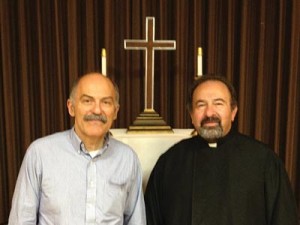Andrew Esguerra
Staff Writer

Photo: Ken Melkonian
On the evening of March 21, the eyes of the congregation were glued to a slideshow of historical Armenian manuscripts painting, presented to community members at the St. Gregory the Illuminator Armenian Apostolic Church of Fowler.
Armenian Studies Program Coordinator, Prof. Barlow Der Mugrdechian, spoke as part of the Lenten Series organized by Rev. Fr. Archpriest Yeghia Hairabedian, pastor of the Church. Following evening prayers and worship in the Church’s Markarian Social Hall, Prof. Der Mugrdechian delivered a lecture on the art of Armenian manuscripts and their spiritual background.
There are more than 30,000 Armenian manuscripts that have survived the centuries, scattered in various collections throughout the world. The largest collection of more than 13,000 is housed in the Matenadaran, in Yerevan. Another 4,000 are held at the St. James Monastery, in Jerusalem, and a similar amount of manuscripts are found in the Mekhitarist Monastery on the island of San Lazzaro in Venice.
The most commonly copied text in the Armenian tradition was that of the Gospels, manually copied by scribes and often illustrated. The Gospels were utilized during the Church services and were sometimes donated by a wealthy or prominent household.
Prof. Der Mugrdechian used examples from two illustrated Gospels, to explain the difference in styles and to also explain how the paintings expressed the faith of the Armenians.
The first manuscript Der Mugrdechian presented was the eleventh century “Vehapar Gospel,” executed in a naive, monastic style, with two-dimensional images and use of less vibrant colors. However the images are striking in their simplicity, painted by monks in an isolated area of Armenia.
The second manuscript discussed was the “Mughni Gospel,” also from the eleventh century, but executed in a “royal,” or “sumptuous” style. The scenes in this manuscript are vibrant, more artistically and aesthetically pleasing, and demonstrate depth and perspective. The “Mughni Gospel” contains a full cycle of illustrations from the life of Christ, including scenes of the angel Gabriel revealing news to Mary about the birth of her son Jesus (The Annunciation); a Nativity scene; the Baptism of Jesus; Jesus entering Jerusalem on a donkey; the Last Supper; the Crucifixion and Resurrection; and the Ascension. Artwork also graced the Canon Tables (an index to the Gospels) and the donor page, at the beginning and very end of the Gospel, respectively.
The images of the centuries-old manuscripts capture the intensity of the Armenian passion for their faith. Writing out the word of God by hand was not enough for them; they added flourishes to the initial letter in paragraphs, illuminated the parchment with beautiful paintings, and bound the book, sometimes using precious metals or gems.
The Armenians have valued the manuscripts over the centuries, through a very long and turbulent history, often at a high personal cost. One such example that Professor Barlow cited was that of a large manuscript, wider than one’s arm span, that two Armenians women cut in half and carried on their backs to safety to keep the manuscript out of the hands of invading Turks.
The art of the Armenian manuscript simultaneously expresses the faith of the Armenian people as well as reminds us of a time where there was no convenient or easy way to prepare the manuscripts. The effort that went into making the manuscripts is a testament to the Armenians’ drive and dedication to their faith and a reminder of all that we have to be thankful for.
 Hye Sharzhoom Armenian Action
Hye Sharzhoom Armenian Action